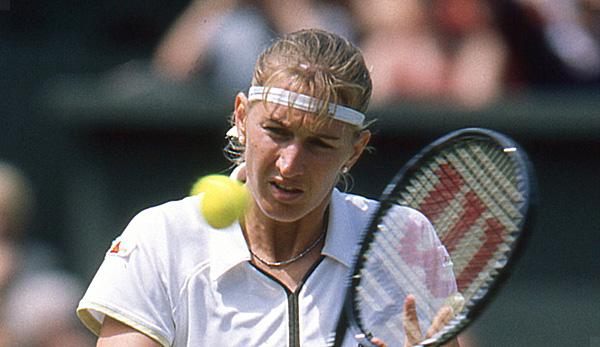Tennis
Wimbledon: Count and Kerber – The legend and its true heiress
It took 22 years – but since July 14, 2018 Steffi Graf has finally found a German successor as Wimbledon winner: Angelique Kerber.
By Jörg Allmeroth from London
It was a few weeks ago when Steffi Graf stood under the Eiffel Tower in Paris and told a little bit about her life on the sidelines of an appointment with a sponsor. Tennis is “only rarely watched from far away Las Vegas”, Graf said, it doesn’t play such a big role anymore. But then the language came to Angelique Kerber, and you immediately noticed that Graf had a look at and for the German top player, that she knows how things are with Kerber.
“I’m glad Angie has regained faith in herself,” she said. And then Graf took another look ahead, to Wimbledon, to the whole season: “Maybe she will win another great title. It is her to trust,” Graf said, “it would be a great joy for me anyway.”
And now this: Wimbledon, Saturday at 18:22 German time. A picture for eternity. The image of Kerber sinking onto the sacred lawn at the moment of greatest happiness. The image of the Queen of the All England Club crying tears of joy. And of course, the eternal reference is not far away in this radiant, historic moment, the reference to Steffi Graf, the legend.
Kerber is now the first player to make the Wimbledon throne since Graf, 22 years after the Grand Master. It also started its legacy here, in the green tennis paradise, there where it counts in tennis. Where careers are accelerated once again in the event of success. “Wimbledon is the tournament of tournaments,” Kerber said in one of the many interviews that evening, “and winning it was the dream of dreams.
And that is since those childhood days when Kerber sat at home in front of the television and saw Graf, her idol. “I watched Wimbledon every second for hours and days,” says Kerber, “and in the end Steffi almost always won.
There are many things that connect Graf and Kerber. It’s not compulsively constructing similarities, it’s just similarities in character – the way they both understood their profession in the professional business. And how they get along in the glitter and glamour industry, in the fancy hustle and bustle that is often presented or even fooled.
Kerber is most comfortable when she is on the training ground or playing matches. Like the former “Miss Forehand” (New York Times), she prefers to avoid the glare of the spotlight. What also unites Graf and Kerber: They trust only a very narrow circle of advisors and most of all the family. When Kerber was already on her way to the top regions of the world ranking list in 2016, she often fled from the public and media hype to Poland, the home of her grandparents.
There she also opened a training academy where she completed her training blocks in peace and quiet. Nobody, really nobody disturbed her there. “It’s my absolute retreat,” says Kerber. “Here I’m always in balance.”
However, Kerber has also sought advice and help a few times during silent visits to Las Vegas, with the great Countess, the woman from the television of her childhood days. A joint sponsor had arranged the trip, Kerber then spent a few days with the 22-time Grand Slam winner.
It was the time of a small crisis back then, after winning the Australian Open Kerber had fallen into a performance gap. Andre Agassi, Count’s husband, played a few training sessions with Kerber, but more important were the talks with the two superstars about how to deal with the sudden glory. “It was about developing more composure, accepting the changed life.
And not to get crazy when things aren’t going so well,” says Kerber. The year 2016 was another wonderful year: Kerber was in the Wimbledon final, she won Olympic silver in Rio, became US Open winner and took first place in the world rankings. At the end of the year she thanked the famous couple in Las Vegas, Count and Agassi.
Wimbledon has always been the fixed point in Graf’s thoughts and actions. And he was with Kerber, too. “I started playing tennis because of Wimbledon,” says the 30-year-old, “I always wanted to win it once. At least once.” By 2017, however, this goal was far, far away. Kerber had once again slipped into crisis, even deeper than before – the gigantic year 2016 was finally followed by a black year.
A season to forget.
Kerber fought more with herself than with her opponents. She wanted to do everything right, win the matches on the court, make a handsome figure in the number one player’s rush. But it didn’t work, Kerber became a doubter, a brooder. At some point it seemed as if everything had only been a fleeting magic, she lost her place on top, was again one of many top players. But no longer the dominant, defining force.
Maybe it was Wimbledon’s dream that set something free in Kerber that is untypical for her: Namely the courage to open up to new people, also the will for radical change. But she did so at the end of 2017, her faithful partner Torben Beltz left the Kerber team, the Belgian Wim Fissette came as head coach, and the renowned physiotherapist Andre Kreidler arrived.
“She turned everything upside down. She has also reinvented herself to some extent,” says Aljoscha Thron, manager and agent Kerbers. Throne also says it had to do above all with Wimbledon: “This calculation was still open. She wanted to win here, otherwise her career wouldn’t have been complete.”
Part 1: The meaning of Wimbledon, Kerber’s relationship to Graf
Part 2: The Influence of Wim Fissette, Rittner’s Praise for Kerber













You must be logged in to post a comment Login